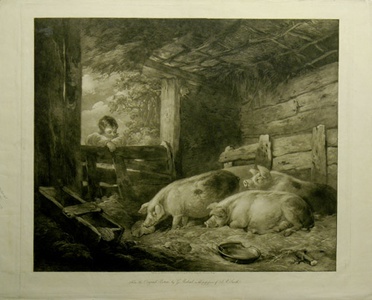| Method | Mezzotint |
| Artist | John Raphael Smith after George Morland |
| Published | Engraved by I. R. Smith, and Published 1st. Jany. 1807, by Thos. Palser, Surrey Side, Westminster Bridge. |
| Dimensions | Image 485 x 602 mm, Plate 553 x 655 mm, Sheet 590 x 840 mm |
| Notes |
Inscribed beneath image with title. A boy looking into a pig-sty, leaning with both elbows on the rough wooden boards watches three pigs sitting in the straw on the right, one eating a cabbage leaf. This mezzotint is after one of the thirty-six paintings George Morland exhibited at John Raphael Smith's shop in King Street, Covent Garden. Smith also exhibited the original painting in the Morland Gallery alongside Feeding the Pigs. D'Oench rejects the attribution of this print to John Raphael Smith. John Raphael Smith (1752 - 1812) was an English painter, mezzotint engraver and print publisher. He was the son of Thomas Smith of Derby, the landscape painter, and father of the painter John Rubens Smith. Smith worked as a linen draper before engraving and publishing the popular Public Ledger. Smith reproduced around forty works after Reynolds, and many after his friend George Morland. In 1802 he announced his retirement from printmaking in favour of portraiture, and subsequently sold 400 of his copper plates at Christie's. George Morland (1763 - 1804) was an English painter. He is best known for his naturalistic and affectionate depictions of animals and rural scenes. Apprenticed to his father, the painter and engraver, Henry Robert Morland (c.1719 - 1797), Morland showed a remarkable talent from a young age, exhibiting at the Royal Academy at the age of ten. As a young man he rejected an apprenticeship with the portrait painter George Romney (1734 - 1802), in favour of moving to France. In 1786 he married Anne Ward (the sister of the engraver William Ward and artist James Ward), and settled in London. It was around this time that Morland painted the Laetitia series, The Idle and Industrious Mechanic, and The Idle Laundress and the Industrious Cottager. He quickly gained a reputation for his artistic work, as well as for his extravagant expenditure. Morland constantly moved around England to escape his creditors, and was imprisoned twice due to his debts. Convulsive fitting led to his death on 29 October 1804. His wife died three days later. A regular exhibitor at the Royal Academy, it is estimated that Morland produced over nine hundred paintings and a thousand drawings in the last eight years of his life. Thomas Palser was a British publisher active between 1803 and 1843. Palser dealt with a wide range of material, from portrait engravings through to caricatures, and restrikes of earlier plates. Based in Surrey Side, Westminster Bridge, London (1803 to 1816), Palser later moved to Harp Alley, Fleet Street (1820-1843). Palser also had premises near Magdalen Bridge, St. Clements, Oxford at the same time as his Fleet Street address. Chaloner Smith undescribed, Frankau 75, Lennox-Boyd i/i Ex. Col.: Hon. Christopher Lennox-Boyd Condition: Excellent impression, good margins on all sides, slightly frayed at edges of sheet, paper split along plate mark. |
| Framing | unmounted |
| Price | £500.00 |
| Stock ID | 29067 |

